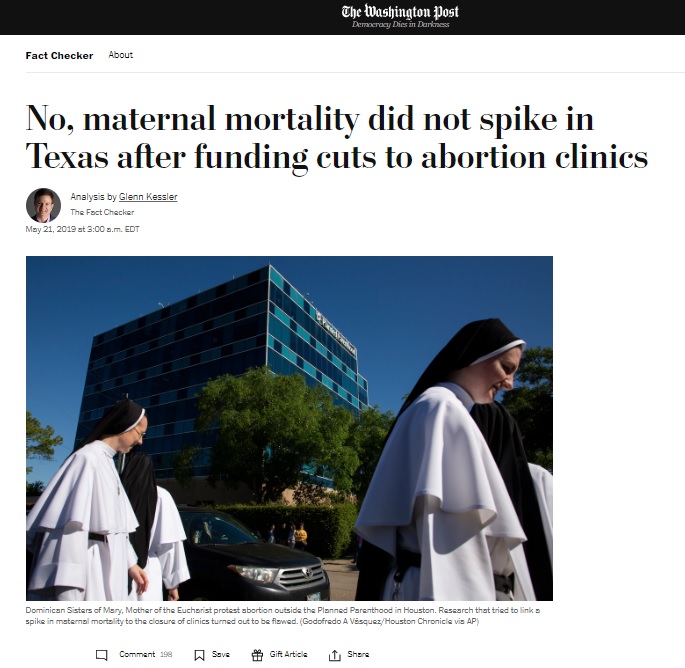A study just published by the Commonwealth Fund, which claims that states that have banned or restricted abortion have higher rates of maternal and infant deaths than states that protect abortion, is flawed. According to Dr. Michael New, Research Associate of Political Science and Social Research at The Catholic University of America and an Associate Scholar at the Charlotte Lozier Institute, the study actually “fails to provide any meaningful evidence that protective pro-life laws lead to worse public health outcomes.” (emphasis added)
“The U.S. Maternal Health Divide: The Limited Maternal Health Services and Worse Outcomes of States Proposing New Abortion Restrictions” correlated groups of data without proving actual causation, yet was cited by multiple media outlets.
According to the study, the authors examined “states that have or are likely to have bans or restrictions on abortion access with states that will preserve abortion access.” How one reaches a conclusion using data from states “likely” to have restrictions is unclear, but they concluded that “[c]ompared to states where abortion is accessible, states that have banned, are planning to ban, or have otherwise restricted abortion have fewer maternity care providers; more maternity care ‘deserts’; higher rates of maternal mortality and infant death, especially among women of color; higher overall death rates for women of reproductive age; and greater racial inequities across their health care systems.”
Dr. Michael New disagreed with the conclusion, telling Live Action News that “the public health data analyzed in this study comes from 2018, 2019, and 2020. During this time, abortion was legal in all 50 states and each state had at least one abortion facility. As such, the state level disparities in the availability of abortion are far less than the authors indicate.
“Second, the authors use a flawed measure by the Guttmacher Institute to categorize states in terms of their abortion policy,” he stated. “This Guttmacher measure captures the number of pro-life policies a state has in place. However, it does not look at abortion rates, the number of abortion facilities, or other factors that measure the availability of abortion.”
Maternal Mortality
The false claim that pro-life laws increase maternal deaths was previously debunked by the Washington Post Fact Checker which wrote regarding the state of Texas (emphasis added):
ProPublica has documented, maternal mortality statistics in the United States are incomplete and highly suspect, prone to undercounting and overcounting. Since 2003, states have added a checkbox to death certificates, asking whether a person was pregnant when they died or had been in the previous year. But the data collection is not consistent, and the addition of a checkbox appears to have resulted in many false positives.
As a result, since 2007 the United States hasn’t had an official annual count of pregnancy-related fatalities, or even an official maternal mortality rate.
So anyone trying to tie a link between abortion laws and mortality rates is going to run into trouble.
Data from the Centers for Disease Control shows that nationally in 2020, “861 women were identified as having died of maternal causes in the United States, compared with 754 in 2019. The maternal mortality rate for 2020 was 23.8 deaths per 100,000 live births compared with a rate of 20.1 in 2019.”
The Commonwealth Fund defined a maternal death as “deaths during pregnancy, at birth, or within 42 days of birth” and concluded in their study that “maternal death rates were 62 percent higher in 2020 in abortion-restriction states than in abortion-access states (28.8 vs. 17.8 per 100,000 births).”

Maternal Mortality Fact Check WAPO
The report also pointed out that “[m]aternal deaths are high in the U.S. relative to other high-income countries, and there are significant inequities by race and ethnicity.” Yet, according to Dr. New, if one is to rely upon Commonwealth Fund’s methodology, what is the explanation for lower maternal mortality rates among countries with more protective pro-life laws than the United States?
“Overall, a substantial body of international data shows that pro-life laws are consistent with strong maternal health outcomes,” Dr. New stated. “Poland, which has among the strongest protective pro-life laws in Europe, also has one of the lowest maternal mortality rates in Europe.”
“Prior to legalizing abortion in 2018, Ireland had lower rates of maternal deaths, low weight births, and breast cancer than England and Wales, and Scotland. Similarly, academic research using data from Chile shows that maternal mortality rates continued to fall after protections for preborn children were enacted in 1989,” New said. “Furthermore, peer reviewed studies have shown that states with pro-life parental involvement laws reduce teen suicide rates and teen STI rates.”
Maternity Care Deserts
The Commonwealth Fund also looked at so-called maternity deserts, citing data from a March of Dimes report which found that 36% of all U.S. counties are “maternity care deserts.” Yet, as Live Action News previously pointed out, despite this disparity, abortion advocates continue to prioritize abortion over actual health care. In addition, the media and pro-abortion groups consistently prop up Planned Parenthood as a health care organization for women — which offers little by way of prenatal care while garnering over 41% of the national abortion market share.
“Our analysis shows that 39 percent of counties in abortion-restriction states can be considered maternity care deserts, compared with 25 percent of counties in abortion-access states. This disparity may be partially explained by the greater number of births in abortion-restriction states that occur in rural areas, where access to maternity care is more limited and maternity care deserts are more common. Rural areas account for 17 percent of births in abortion-restriction states, but only 8 percent in abortion-access states,” the Commonwealth Fund report stated.
But the report goes on to claim that “abortion-restriction states also have fewer maternal care providers than states with abortion access, including a 32 percent lower ratio of obstetricians to births and a 59 percent lower ratio of certified nurse midwives to births.”
The study failed to provide a reason for these shortages other than insinuating that this is somehow linked to pro-life legislation. But a 2018 report by the Association of American Medical Colleges (AAMC) gives more clarity:
The growing OB-GYN shortage is mostly a matter of demand exceeding supply. In recent decades, the number of U.S. women over age 18 has increased by 33 million — yet OB-GYN first-year residency positions grew by less than 200 between 1992 and 2016. In addition, many OB-GYNs are nearing retirement: their average age is 51, and they tend to retire beginning at 59. Some may consider leaving in part because of their specialty’s high likelihood of being sued.
Still, Dr. New noted the Commonwealth Fund’s methodological shortcomings, claiming the authors failed to “control for important confounding variables — like per capita income or poverty rates.” He added, “Indeed, the main reason why the pro-life states fare worse on some public heath metrics is that many of these pro-life states are southern states which tend to have lower per capita incomes and higher poverty rates. Research shows that high incomes are linked with better public health. As such, this study shows a correlation between income and public health outcomes. It fails to make a convincing argument that the presence of pro-life laws is responsible for either high maternal death rates or high infant death rates.”
Nonetheless, Dr. New pointed out that pro-lifers should not be distracted by this study, because he said, “Good research shows that pro-life laws can protect both mother and child.”








